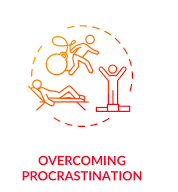Table of Contents

Introduction
Procrastination—it’s the silent saboteur of dreams, the thief of time, and an ever-present challenge that plagues the vast majority of us. Whether we’re dodging that colossal work project or simply putting off the day’s chores, procrastination has a knack for weaving its way into our lives, sabotaging our productivity and stealing our precious moments. According to a comprehensive study conducted in 2022, nearly one in five adults confess to being chronic procrastinators. The implications? Missed opportunities, escalated stress levels, and a stagnation in personal and professional growth that can leave us feeling unfulfilled and overwhelmed.
But fear not, for there is a silver lining to this cloud of inertia: procrastination is not an innate characteristic, nor is it an insurmountable hurdle. With the appropriate strategies, understanding, and mindset, we can all learn to conquer this time-wasting nemesis. This blog post serves as a thorough guide, detailing five scientifically-backed strategies to help you banish procrastination and unlock your full potential. By the time you reach the conclusion, you’ll be armed with the knowledge and tools necessary to reclaim your time and march triumphantly towards the realization of your goals.
Let’s embark on this journey together.
Unraveling the Root Causes of Procrastination
Before we delve into the solutions that can help us conquer procrastination, it’s vital that we first understand the underlying causes. Procrastination is not merely a question of poor time management—it often stems from a complex tapestry of emotional and psychological factors that can be deeply entrenched in our behavior.
Defining Procrastination and Its Variants
In the realm of psychology, procrastination is characterized as the intentional postponement of actions that we aim to undertake, despite our awareness of the negative repercussions that will inevitably follow. There are two primary types of procrastination that we tend to grapple with:
- Task-Based Procrastination: This is the kind where we find ourselves endlessly delaying tasks that we perceive as dull, cumbersome, or otherwise unenjoyable. It’s easy to rationalize avoiding these tasks, convincing ourselves that there are more pressing matters at hand.
- Emotional Procrastination: Here, the procrastinator is driven by fear of failure, a desire to evade negative feelings, or a deep-seated perfectionism that paralyzes their ability to begin. These individuals may find themselves avoiding tasks due to self-doubt or the anxiety that comes with facing potential imperfection.
Understanding Your Procrastination Patterns
To effectively tackle procrastination, it’s crucial to become aware of our own personal triggers. This can be achieved through introspection and self-analysis. Keep a procrastination log to track:
- The tasks you frequently put off.
- The emotions you experience when you decide to delay these tasks.
- The excuses you habitually employ to justify your procrastination.
By examining these patterns, we can start to unravel the mysteries behind our procrastinatory tendencies, laying the groundwork for meaningful change.
Strategy One: The Mastery of Time Management
Time is a precious commodity, and procrastination has a sneaky way of siphoning it off without us even realizing. However, by embracing robust time management strategies, we can regain control and optimize our daily routines.
The Significance of Time Management
When we fail to manage our time effectively, we often find ourselves in a perpetual cycle of rushing to meet deadlines and churning out subpar work. On the flip side, when we plan and allocate our time with intention, we can prioritize the tasks that truly matter, thereby reducing stress and increasing the quality of our output.
Tried-and-True Techniques
- The Pomodoro Technique: This method involves dividing your work into 25-minute segments, separated by brief, 5-minute breaks. It’s an excellent way to maintain focus and stave off fatigue.
- Time Blocking: Schedule specific time slots for each task or activity in your calendar. This helps to create a structured day and minimize the temptation to procrastinate.
- The Eisenhower Matrix: This tool helps us to prioritize tasks by categorizing them into four quadrants: urgent and important, important but not urgent, urgent but not important, and not urgent or important. This way, you can tackle the tasks that truly demand your immediate attention while deferring the rest.
Real-World Application
Consider the plight of a freelance writer grappling with the looming deadline of a 3000-word article. By employing the Pomodoro Technique, they can dismantle this Herculean task into bite-sized, manageable chunks, thereby reducing stress and enhancing the quality of their work.


Strategy Two: Dissecting Tasks into Bite-Sized Steps
One of the most daunting aspects of procrastination is the sheer magnitude of the tasks we often face. However, by breaking these behemoths into smaller, actionable steps, we can transform them from intimidating to attainable.
The Science Behind It
When tasks are broken down into smaller components, we tend to experience a sense of achievement with each step completed. This creates a positive feedback loop that motivates us to continue making progress.
Steps to Success
- Start Small: If the prospect of tackling a massive project seems overwhelming, begin with the simplest part. For instance, if you’re writing a report, start by drafting the title page or outline.
- The Two-Minute Rule: If a task can be completed in less than two minutes, do it immediately. This prevents the buildup of small, quick tasks into a mountain of procrastination.
- Chunking Large Tasks: Divide projects into distinct phases, such as research, writing, and editing. This makes the process more manageable and less intimidating.
Real-Life Example
Imagine a student bracing for the onslaught of final exams. Instead of attempting to cram an entire semester’s worth of knowledge into their brain in one marathon study session, they can:
- Break down study material into daily goals.
- Summarize key concepts and theories.
- Regularly test themselves on these small sections.
By taking this systematic approach, the student not only reduces their stress levels but also enhances their ability to retain information.
Strategy Three: Creating a Conducive Work Environment
The environment in which we operate has a profound influence on our capacity to focus and be productive.
The Physical Workspace
- Eliminate Distractions: Clear your desk of clutter, silence your phone notifications, and use tools such as Freedom or StayFocusd to block distracting websites.
- Organize Your Surroundings: Arrange your workspace to include only the essentials: computer, notebook, and a glass of water. This minimalist approach can help maintain focus.
- Lighting and Ergonomics: Utilize natural light to the best of your ability and invest in a comfortable chair that supports good posture, as prolonged discomfort can hinder concentration.
The Mental Environment
A productive environment is not solely about the physical space. It’s equally important to cultivate a mental environment that fosters concentration and efficiency.
- Digital Hygiene: Set designated times for checking emails and limit social media usage to designated breaks. This prevents the constant digital distractions that can so easily derail our focus.
- Mindfulness Practices: Engaging in mindfulness activities can significantly reduce stress and keep us anchored in the present moment, thereby improving our ability to work effectively.
Case Study
A software developer who frequently found themselves sidetracked by distractions took the initiative to revamp their workspace. By decluttering and incorporating noise-canceling headphones into their routine, they experienced a notable increase in concentration and project completion times.


Strategy Four: The Art of Habit Formation
Habits are the bedrock of our daily routines, and developing strong, positive habits is a surefire way to combat procrastination.
The Anatomy of Successful Habits
- Start with Small Commitments: Instead of setting lofty goals, commit to small, achievable actions that can be integrated into your existing routines, such as writing 100 words daily rather than aiming to complete an entire chapter.
- Utilize Triggers and Rewards: Associate new habits with established routines (like reviewing your to-do list while enjoying your morning coffee) and reward yourself upon task completion. This can help to create a powerful psychological link between the action and positive reinforcement.
Tools to Assist in Habit Building
There are numerous applications available, such as Habitica, Streaks, and Beeminder, that transform habit formation into a game-like experience, keeping you engaged and motivated.
Overcoming Challenges
- Anticipate Setbacks: It’s natural to encounter hiccups on the path to change. The key is to acknowledge them as part of the process and to develop strategies for dealing with them when they arise.
- Embrace Consistency: The road to forming a new habit is paved with gradual progress. Celebrate each step forward, regardless of how small it may seem.
Real-World Application
A content creator struggling with productivity discovered that by joining a virtual coworking group, they could leverage the power of collective focus and shared goals to boost their output.
Strategy Five: The Power of Accountability
When we know that others are invested in our success, we’re significantly more likely to stick to our commitments.
Fostering Accountability
- Enlist an Accountability Partner: Share your goals with a trusted friend or colleague who can regularly check in on your progress.
- Make Public Commitments: Announce your intentions on social media or within a community. The social pressure to follow through can be surprisingly effective.
- Engage in Supportive Communities: Participate in online forums, join a study group, or find a coworking space to surround yourself with like-minded individuals who can encourage and motivate you.
Professional Support
For those grappling with chronic procrastination, professional help from a coach or therapist can provide invaluable guidance and encouragement.
Real-World Example
A content creator who was struggling to meet deadlines and produce high-quality work found that by enlisting an accountability partner, they could maintain their commitment to their projects, leading to a significant improvement in productivity.
Overcoming Procrastination Mental Barriers
Procrastination is often the handiwork of mental barriers like fear and doubt. To truly conquer it, we must learn to address these psychological obstacles.
Addressing Common Excuses
- “I’ll do it later” → Replace with “What small step can I take now?”
- “It’s too hard” → Break it into simpler, more manageable tasks.
Shifting Your Mindset
- Practice Gratitude: Reflect on what you’ve accomplished to keep yourself motivated and focused on the positive aspects of your work.
- Use Visualization: Imagine the successful completion of your tasks to build confidence and momentum.
Real-World Application
A sales professional who frequently put off making calls found that by reframing their thoughts and employing visualization techniques, they could overcome their fear of rejection and significantly increase their productivity.
Long-Term Advantages of Vanquishing Procrastination
The rewards of conquering procrastination are manifold, extending far beyond the immediate relief of a completed to-do list.
- Improved Productivity: Achieve more in less time, leaving you free to pursue other interests and passions.
- Enhanced Mental Health: Reduced stress and increased self-esteem are byproducts of a more organized and productive lifestyle.
- Career Advancement: Meeting deadlines and achieving milestones can propel you forward in your professional journey.


Conclusion
Procrastination may be a pervasive challenge, but it doesn’t have to define our lives. By implementing the five strategies outlined in this blog post, we can begin to take charge of our time and transform our productivity. Remember, the path to becoming a procrastination-slayer is paved with small, deliberate actions.
Embracing these strategies and making a commitment to change can lead to a more fulfilling and successful life. It’s essential to recognize that this is not a one-time fix but rather a continuous process of growth and improvement. Each day presents us with new opportunities to implement these tactics and inch closer to our goals.
So, let’s take that first step today. Start small, be patient with yourself, and watch as the cumulative effect of these changes reshapes your relationship with time and productivity. The journey may be long, but the destination—a life unencumbered by procrastination—is well worth the effort.
How Exercise Can Improve Mental Health: 5 ways physical activity changes your brain
Introduction: The Mind-Body Symphony Everything feels just a bit too much. Yet, in the midst of all this chaos, you […]
Psychology of laughter for stress : 6 Reasons you should laugh more
Introduction Picture this: You’re scrolling through Psychology of laughter for stress your social media feed after a long, exhausting day, […]
How to Master Emotional Self-Care: A Comprehensive Guide to Nurturing Your Mental Health
Introduction In the fast-paced world we live in today, where the demands of work, relationships, and personal aspirations How to […]
Overcoming Procrastination Overcoming Procrastination Overcoming ProcrastinationOvercoming Procrastination Overcoming Procrastination Overcoming Procrastination Overcoming Procrastination Overcoming Procrastination Overcoming Procrastination Overcoming ProcrastinationOvercoming Procrastination Overcoming Procrastination Overcoming Procrastination Overcoming Procrastination Overcoming Procrastination Overcoming Procrastination Overcoming ProcrastinationOvercoming Procrastination Overcoming Procrastination